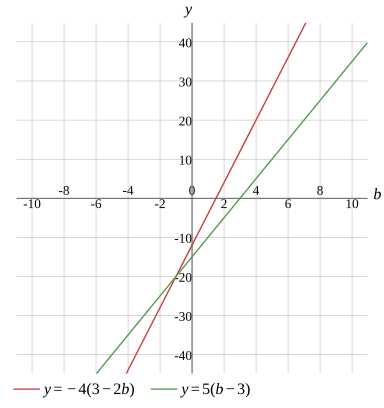Question
Solve the equation
b=−1
Evaluate
−4(3−2b)=5(b−3)
Calculate
More Steps


Evaluate
−4(3−2b)
Apply the distributive property
−4×3−(−4×2b)
Multiply the numbers
−12−(−4×2b)
Multiply the numbers
−12−(−8b)
If a negative sign or a subtraction symbol appears outside parentheses, remove the parentheses and change the sign of every term within the parentheses
−12+8b
−12+8b=5(b−3)
Calculate
More Steps


Evaluate
5(b−3)
Apply the distributive property
5b−5×3
Multiply the numbers
5b−15
−12+8b=5b−15
Move the expression to the left side
−12+8b−(5b−15)=0
Calculate the sum or difference
More Steps


Add the terms
−12+8b−(5b−15)
If a negative sign or a subtraction symbol appears outside parentheses, remove the parentheses and change the sign of every term within the parentheses
−12+8b−5b+15
Add the numbers
3+8b−5b
Subtract the terms
More Steps


Evaluate
8b−5b
Collect like terms by calculating the sum or difference of their coefficients
(8−5)b
Subtract the numbers
3b
3+3b
3+3b=0
Move the constant to the right-hand side and change its sign
3b=0−3
Removing 0 doesn't change the value,so remove it from the expression
3b=−3
Divide both sides
33b=3−3
Divide the numbers
b=3−3
Solution
More Steps


Evaluate
3−3
Reduce the numbers
1−1
Calculate
−1
b=−1
Show Solution

Graph
